steering FORD C MAX 2008 1.G Owner's Manual
[x] Cancel search | Manufacturer: FORD, Model Year: 2008, Model line: C MAX, Model: FORD C MAX 2008 1.GPages: 278, PDF Size: 17.5 MB
Page 101 of 278
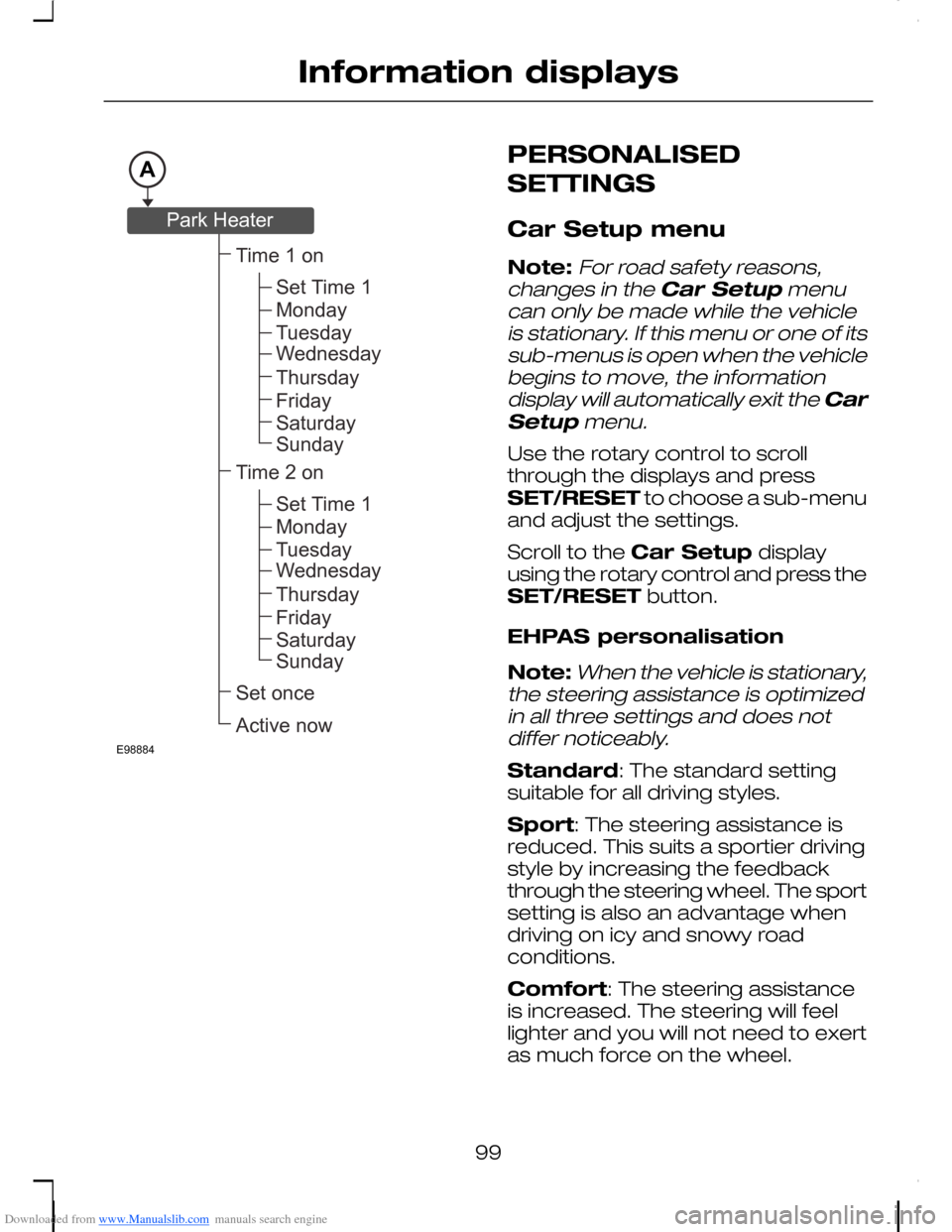
Downloaded from www.Manualslib.com manuals search engine PERSONALISED
SETTINGS
Car Setup menu
Note:For road safety reasons,changes in the Car Setup menucan only be made while the vehicleis stationary. If this menu or one of itssub-menus is open when the vehiclebegins to move, the informationdisplay will automatically exit the CarSetup menu.
Use the rotary control to scrollthrough the displays and pressSET/RESET to choose a sub-menuand adjust the settings.
Scroll to the Car Setup displayusing the rotary control and press theSET/RESET button.
EHPAS personalisation
Note:When the vehicle is stationary,the steering assistance is optimizedin all three settings and does notdiffer noticeably.
Standard: The standard settingsuitable for all driving styles.
Sport: The steering assistance isreduced. This suits a sportier drivingstyle by increasing the feedbackthrough the steering wheel. The sportsetting is also an advantage whendriving on icy and snowy roadconditions.
Comfort: The steering assistanceis increased. The steering will feellighter and you will not need to exertas much force on the wheel.
99
Information displaysAE98884Time1onSetonceActivenowSetTime1MondayTuesdayWednesdayThursdayFridaySaturdaySundayTime2onSetTime1MondayTuesdayWednesdayThursdayFridaySaturdaySundayParkHeater
Page 105 of 278
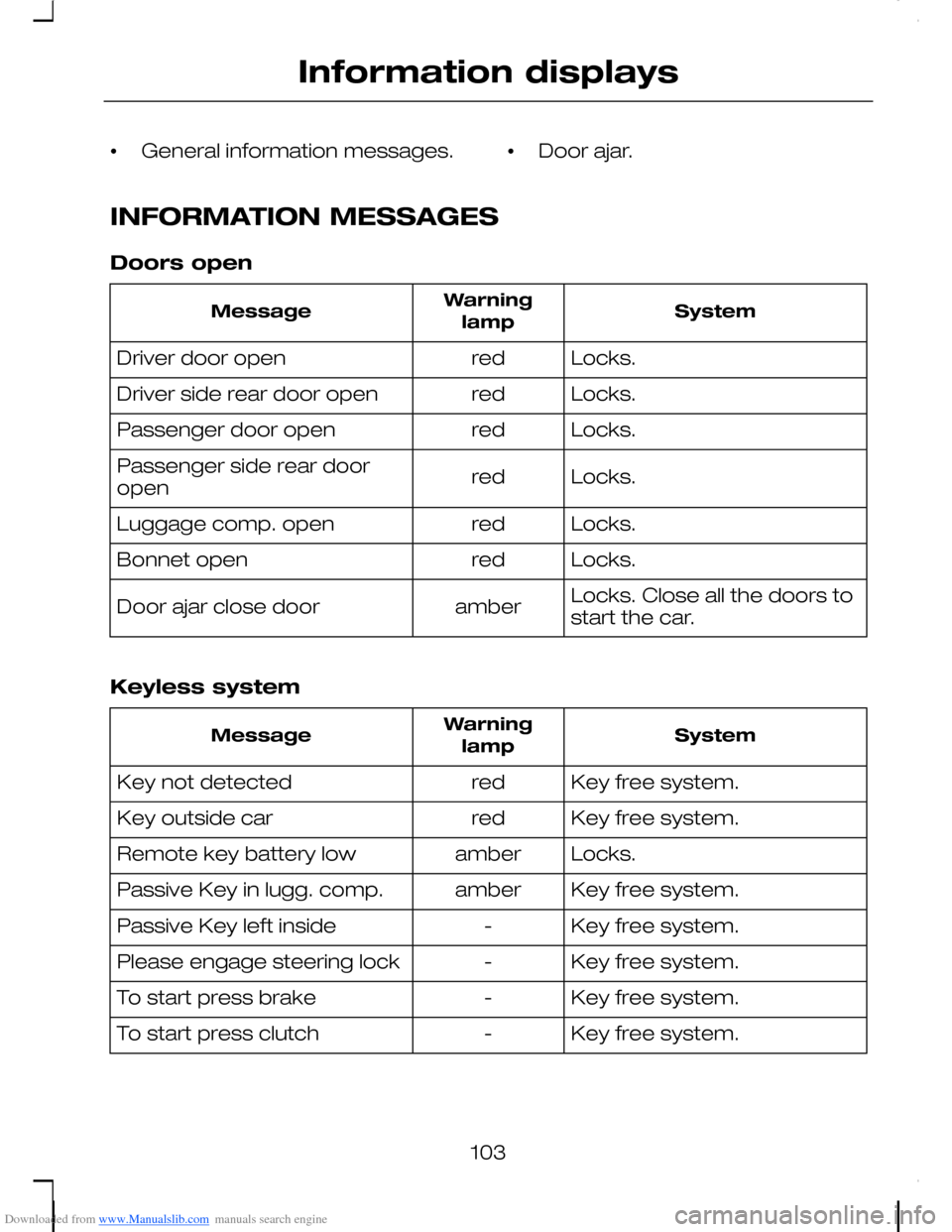
Downloaded from www.Manualslib.com manuals search engine •General information messages.•Door ajar.
INFORMATION MESSAGES
Doors open
SystemWarninglampMessage
Locks.redDriver door open
Locks.redDriver side rear door open
Locks.redPassenger door open
Locks.redPassenger side rear dooropen
Locks.redLuggage comp. open
Locks.redBonnet open
Locks. Close all the doors tostart the car.amberDoor ajar close door
Keyless system
SystemWarninglampMessage
Key free system.redKey not detected
Key free system.redKey outside car
Locks.amberRemote key battery low
Key free system.amberPassive Key in lugg. comp.
Key free system.-Passive Key left inside
Key free system.-Please engage steering lock
Key free system.-To start press brake
Key free system.-To start press clutch
103
Information displays
Page 107 of 278
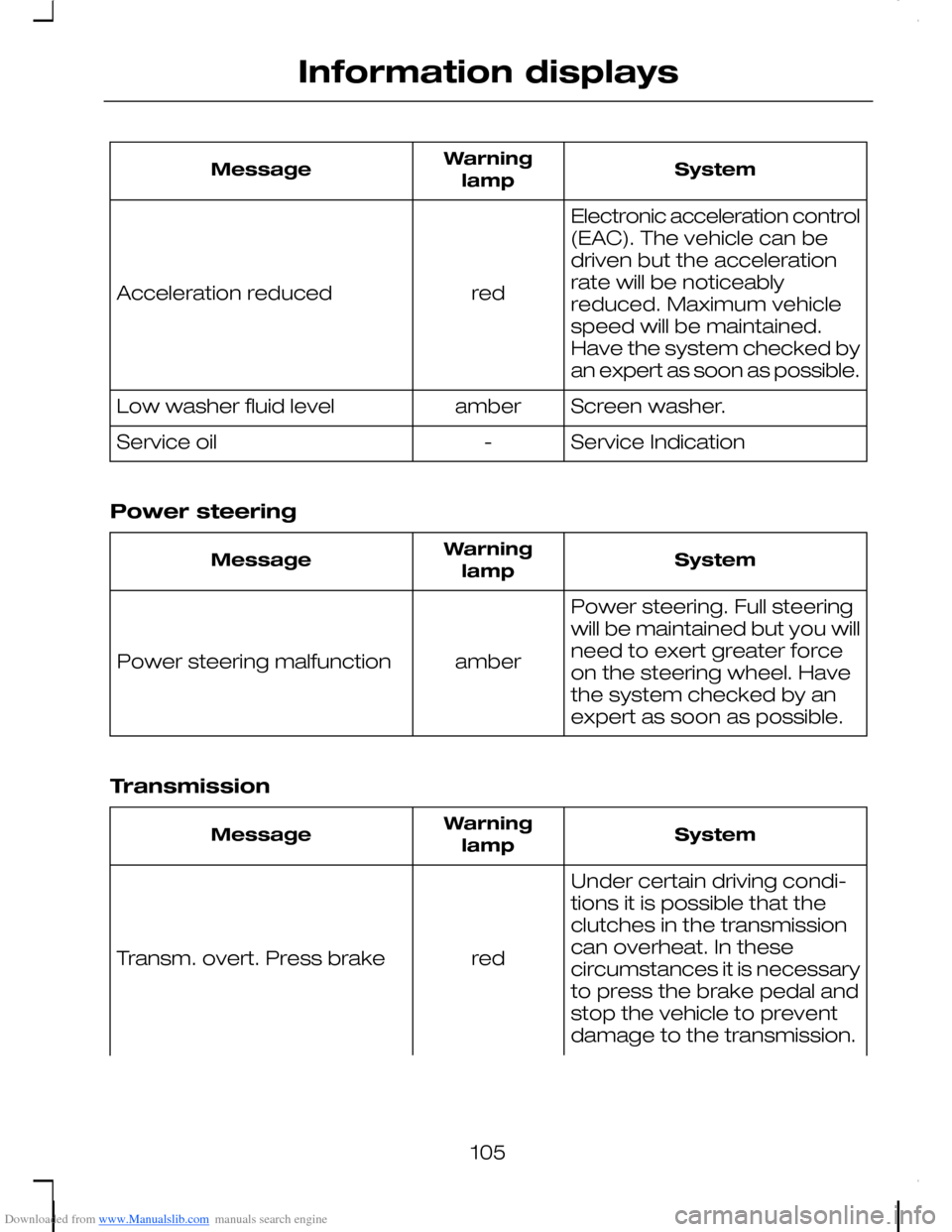
Downloaded from www.Manualslib.com manuals search engine SystemWarninglampMessage
Electronic acceleration control(EAC). The vehicle can bedriven but the accelerationrate will be noticeablyreduced. Maximum vehiclespeed will be maintained.Have the system checked byan expert as soon as possible.
redAcceleration reduced
Screen washer.amberLow washer fluid level
Service Indication-Service oil
Power steering
SystemWarninglampMessage
Power steering. Full steeringwill be maintained but you willneed to exert greater forceon the steering wheel. Havethe system checked by anexpert as soon as possible.
amberPower steering malfunction
Transmission
SystemWarninglampMessage
Under certain driving condi-tions it is possible that theclutches in the transmissioncan overheat. In thesecircumstances it is necessaryto press the brake pedal and
redTransm. overt. Press brake
stop the vehicle to preventdamage to the transmission.
105
Information displays
Page 122 of 278
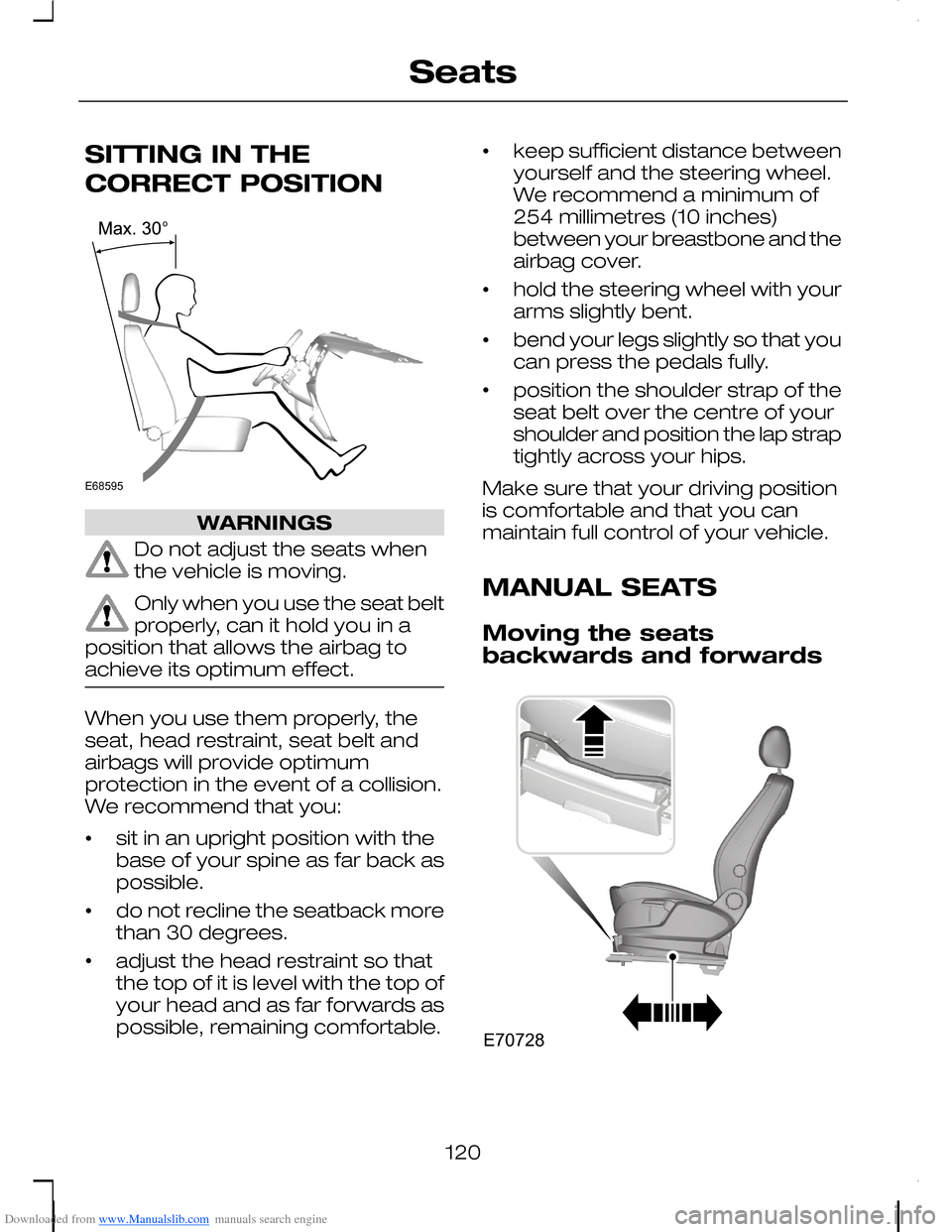
Downloaded from www.Manualslib.com manuals search engine SITTING IN THE
CORRECT POSITION
WARNINGS
Do not adjust the seats whenthe vehicle is moving.
Only when you use the seat beltproperly, can it hold you in aposition that allows the airbag toachieve its optimum effect.
When you use them properly, theseat, head restraint, seat belt andairbags will provide optimumprotection in the event of a collision.We recommend that you:
•sit in an upright position with thebase of your spine as far back aspossible.
•do not recline the seatback morethan 30 degrees.
•adjust the head restraint so thatthe top of it is level with the top ofyour head and as far forwards aspossible, remaining comfortable.
•keep sufficient distance betweenyourself and the steering wheel.We recommend a minimum of254 millimetres (10 inches)between your breastbone and theairbag cover.
•hold the steering wheel with yourarms slightly bent.
•bend your legs slightly so that youcan press the pedals fully.
•position the shoulder strap of theseat belt over the centre of yourshoulder and position the lap straptightly across your hips.
Make sure that your driving positionis comfortable and that you canmaintain full control of your vehicle.
MANUAL SEATS
Moving the seatsbackwards and forwards
120
SeatsE68595 E70728
Page 144 of 278
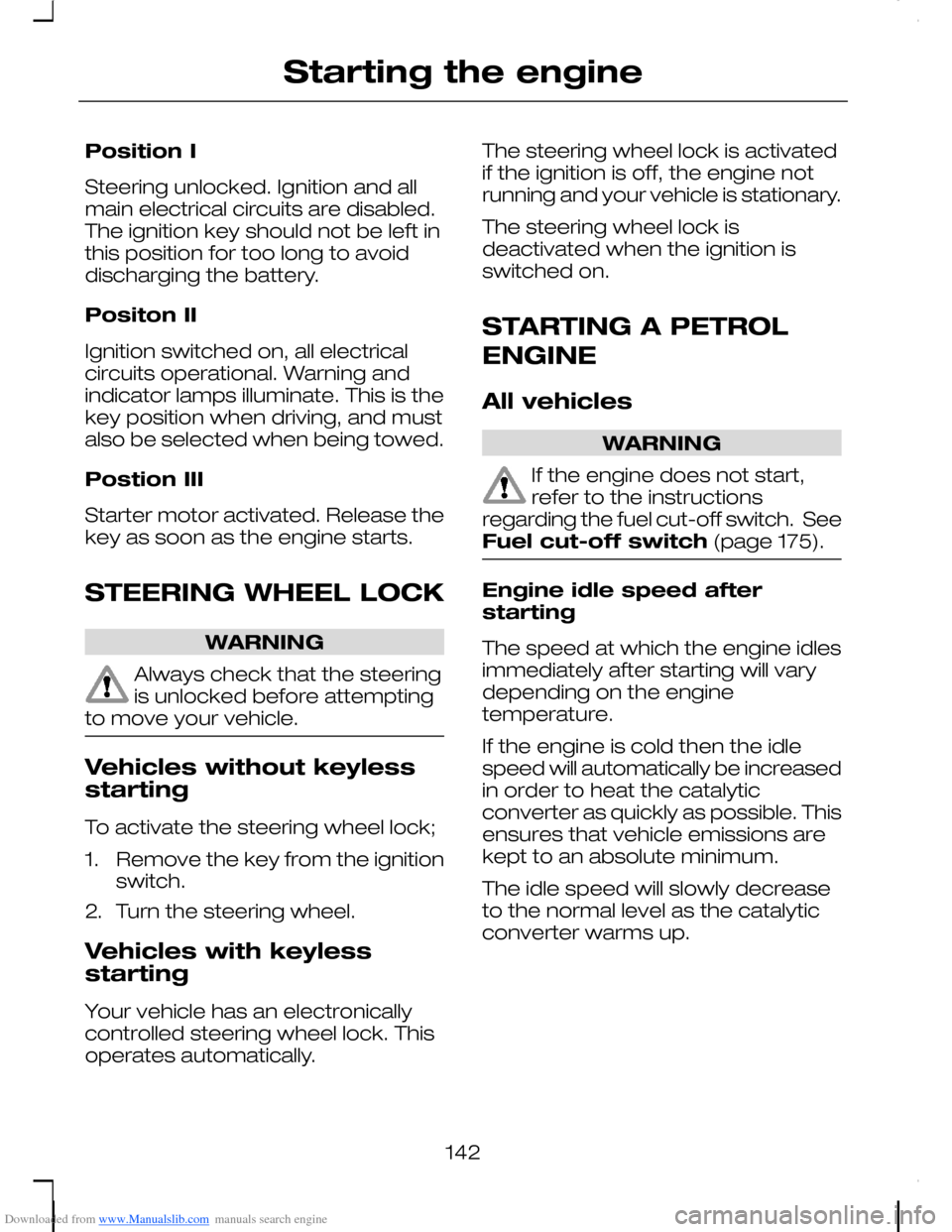
Downloaded from www.Manualslib.com manuals search engine Position I
Steering unlocked. Ignition and allmain electrical circuits are disabled.The ignition key should not be left inthis position for too long to avoiddischarging the battery.
Positon II
Ignition switched on, all electricalcircuits operational. Warning andindicator lamps illuminate. This is thekey position when driving, and mustalso be selected when being towed.
Postion III
Starter motor activated. Release thekey as soon as the engine starts.
STEERING WHEEL LOCK
WARNING
Always check that the steeringis unlocked before attemptingto move your vehicle.
Vehicles without keylessstarting
To activate the steering wheel lock;
1.Remove the key from the ignitionswitch.
2.Turn the steering wheel.
Vehicles with keylessstarting
Your vehicle has an electronicallycontrolled steering wheel lock. Thisoperates automatically.
The steering wheel lock is activatedif the ignition is off, the engine notrunning and your vehicle is stationary.
The steering wheel lock isdeactivated when the ignition isswitched on.
STARTING A PETROL
ENGINE
All vehicles
WARNING
If the engine does not start,refer to the instructionsregarding the fuel cut-off switch. SeeFuel cut-off switch (page 175).
Engine idle speed afterstarting
The speed at which the engine idlesimmediately after starting will varydepending on the enginetemperature.
If the engine is cold then the idlespeed will automatically be increasedin order to heat the catalyticconverter as quickly as possible. Thisensures that vehicle emissions arekept to an absolute minimum.
The idle speed will slowly decreaseto the normal level as the catalyticconverter warms up.
142
Starting the engine
Page 148 of 278
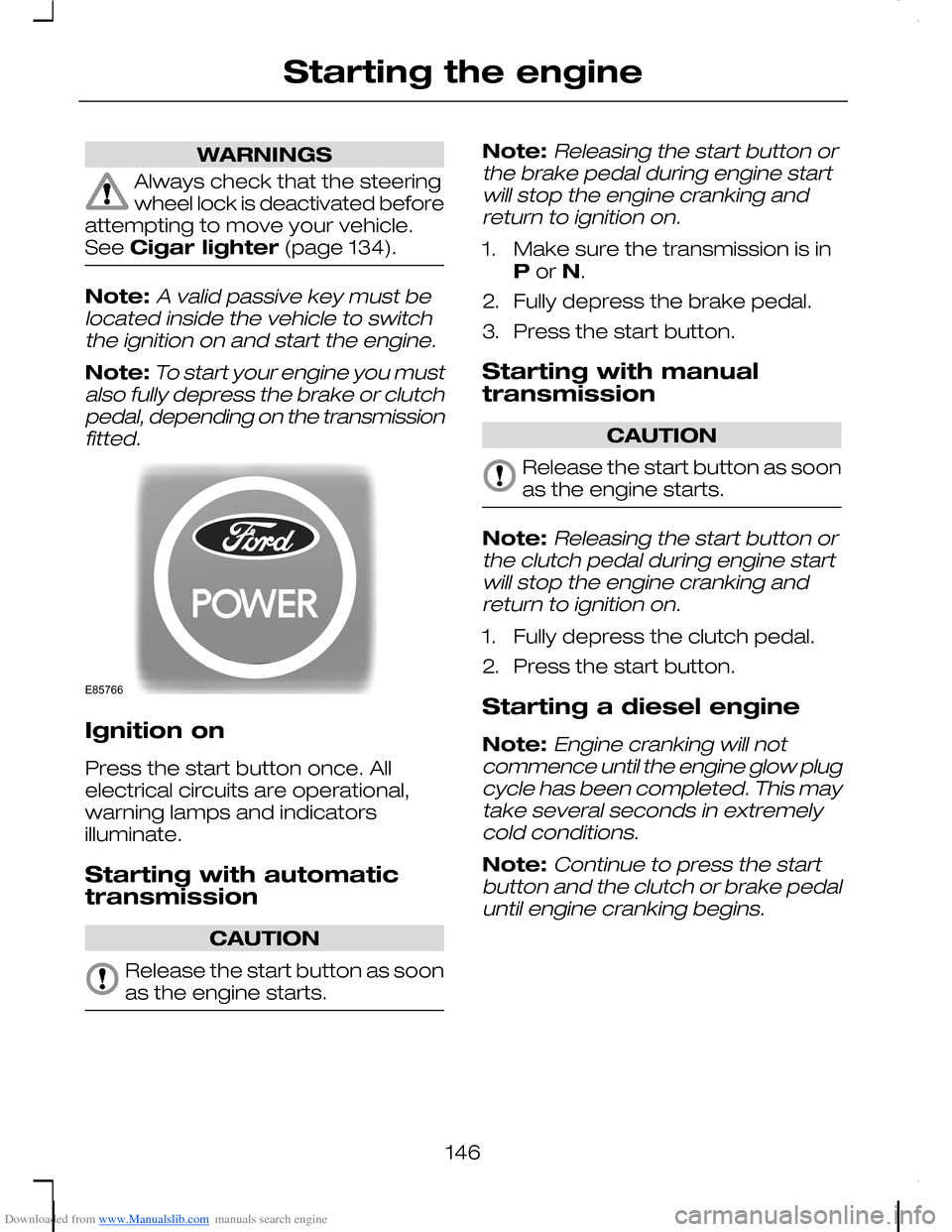
Downloaded from www.Manualslib.com manuals search engine WARNINGS
Always check that the steeringwheel lock is deactivated beforeattempting to move your vehicle.See Cigar lighter (page 134).
Note:A valid passive key must belocated inside the vehicle to switchthe ignition on and start the engine.
Note:To start your engine you mustalso fully depress the brake or clutchpedal, depending on the transmissionfitted.
Ignition on
Press the start button once. Allelectrical circuits are operational,warning lamps and indicatorsilluminate.
Starting with automatictransmission
CAUTION
Release the start button as soonas the engine starts.
Note:Releasing the start button orthe brake pedal during engine startwill stop the engine cranking andreturn to ignition on.
1.Make sure the transmission is inP or N.
2.Fully depress the brake pedal.
3.Press the start button.
Starting with manualtransmission
CAUTION
Release the start button as soonas the engine starts.
Note:Releasing the start button orthe clutch pedal during engine startwill stop the engine cranking andreturn to ignition on.
1.Fully depress the clutch pedal.
2.Press the start button.
Starting a diesel engine
Note:Engine cranking will notcommence until the engine glow plugcycle has been completed. This maytake several seconds in extremelycold conditions.
Note:Continue to press the startbutton and the clutch or brake pedaluntil engine cranking begins.
146
Starting the engineE85766
Page 149 of 278
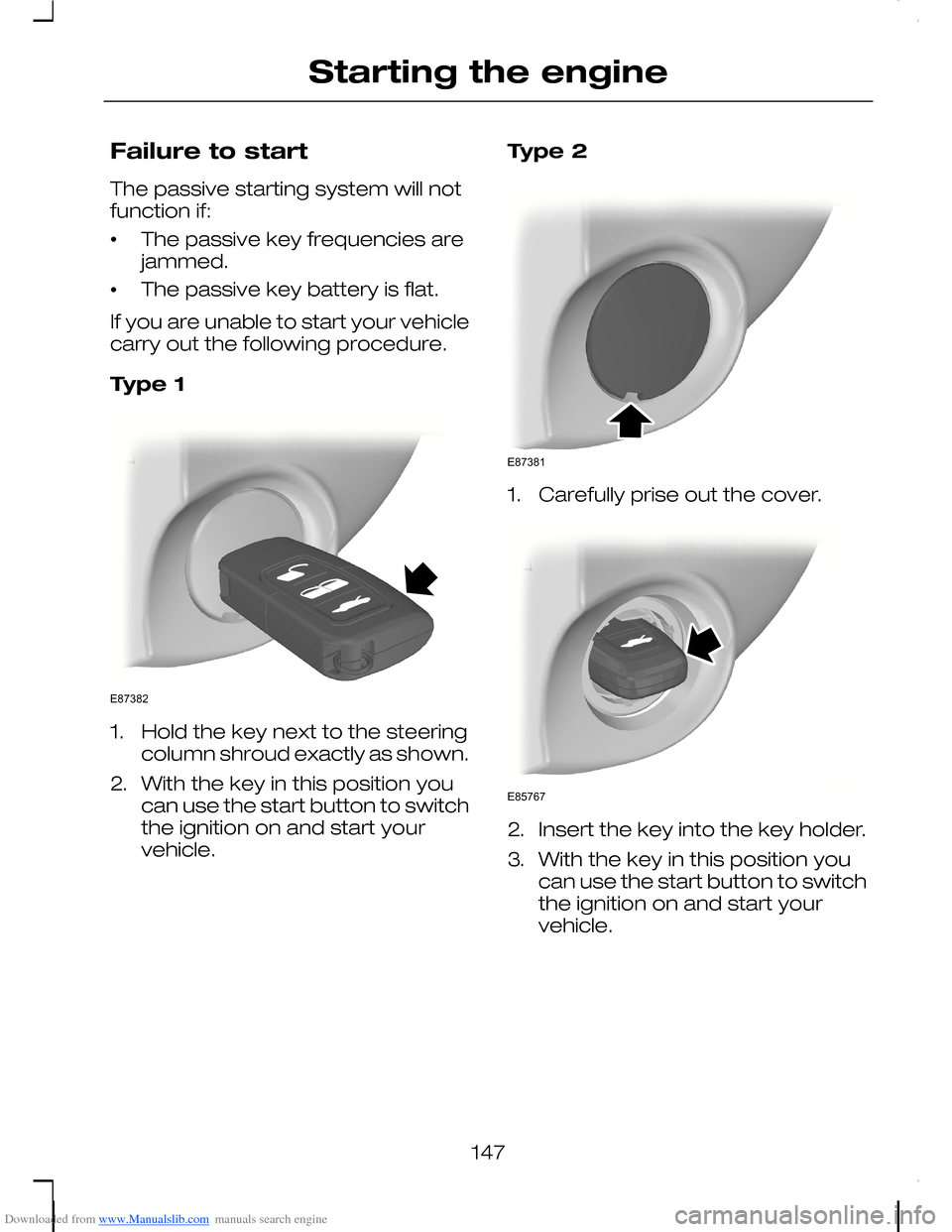
Downloaded from www.Manualslib.com manuals search engine Failure to start
The passive starting system will notfunction if:
•The passive key frequencies arejammed.
•The passive key battery is flat.
If you are unable to start your vehiclecarry out the following procedure.
Type 1
1.Hold the key next to the steeringcolumn shroud exactly as shown.
2.With the key in this position youcan use the start button to switchthe ignition on and start yourvehicle.
Type 2
1.Carefully prise out the cover.
2.Insert the key into the key holder.
3.With the key in this position youcan use the start button to switchthe ignition on and start yourvehicle.
147
Starting the engineE87382 E87381 E85767
Page 160 of 278
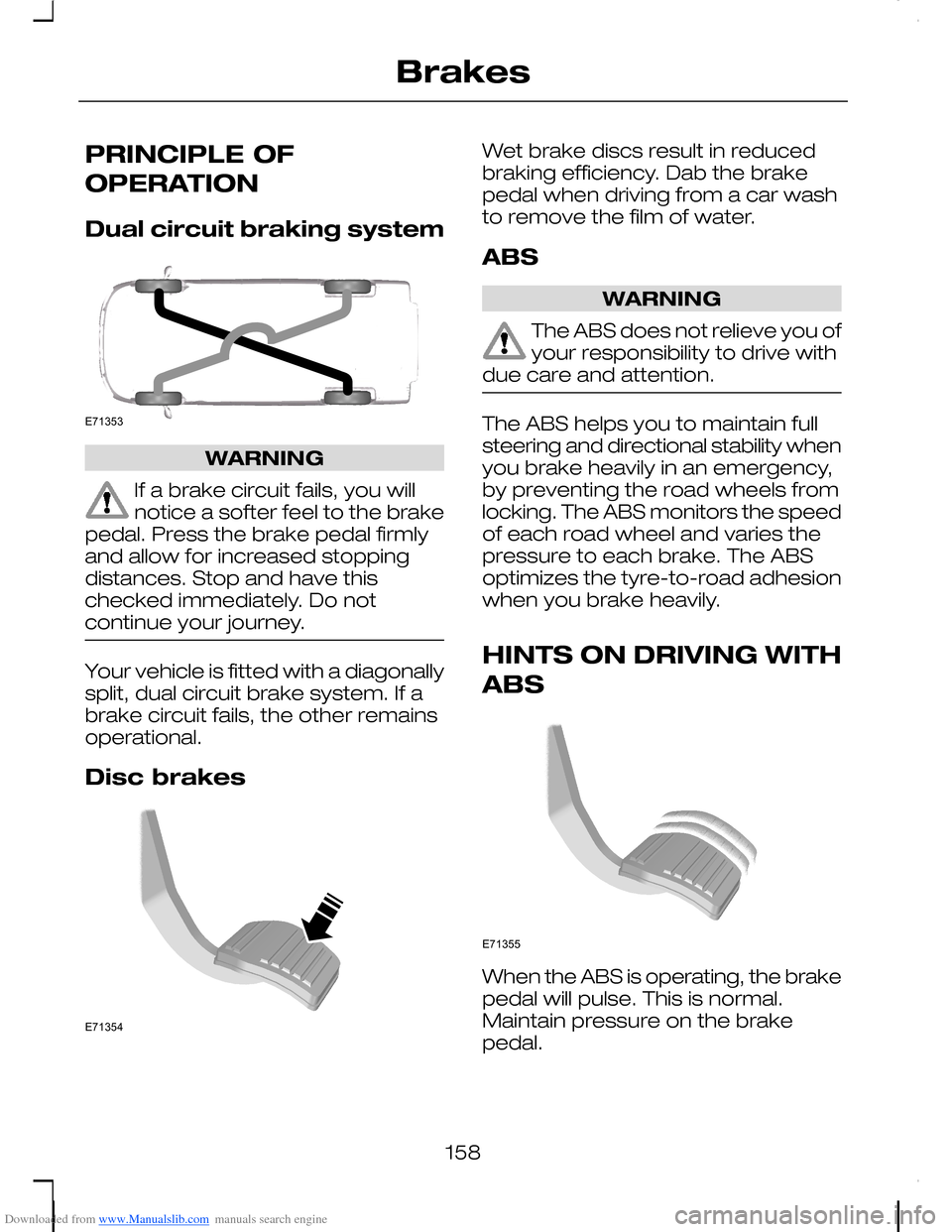
Downloaded from www.Manualslib.com manuals search engine PRINCIPLE OF
OPERATION
Dual circuit braking system
WARNING
If a brake circuit fails, you willnotice a softer feel to the brakepedal. Press the brake pedal firmlyand allow for increased stoppingdistances. Stop and have thischecked immediately. Do notcontinue your journey.
Your vehicle is fitted with a diagonallysplit, dual circuit brake system. If abrake circuit fails, the other remainsoperational.
Disc brakes
Wet brake discs result in reducedbraking efficiency. Dab the brakepedal when driving from a car washto remove the film of water.
ABS
WARNING
The ABS does not relieve you ofyour responsibility to drive withdue care and attention.
The ABS helps you to maintain fullsteering and directional stability whenyou brake heavily in an emergency,by preventing the road wheels fromlocking. The ABS monitors the speedof each road wheel and varies thepressure to each brake. The ABSoptimizes the tyre-to-road adhesionwhen you brake heavily.
HINTS ON DRIVING WITH
ABS
When the ABS is operating, the brakepedal will pulse. This is normal.Maintain pressure on the brakepedal.
158
BrakesE71353 E71354 E71355
Page 161 of 278

Downloaded from www.Manualslib.com manuals search engine The ABS will not eliminate thedangers inherent when:
•you drive too close to the vehiclein front of you.
•the vehicle is aquaplaning.
•you take corners too fast.
•the road surface is poor.
PARKING BRAKE
All vehicles
WARNING
Vehicles with an automatictransmission should always beleft with the selector lever in positionP.
•Press the foot brake pedal firmly.
•Pull the parking brake lever upsmartly to its fullest extent.
•Do not press the release buttonwhile pulling the lever up.
•If your vehicle is parked on a hilland facing uphill, select first gearand turn the steering wheel awayfrom the kerb.
•If your vehicle is parked on a hilland facing downhill, select reversegear and turn the steering wheeltowards the kerb.
To release the parking brake, pressthe brake pedal firmly, pull the leverup slightly, depress the releasebutton and push the lever down.
159
BrakesE70430
Page 166 of 278
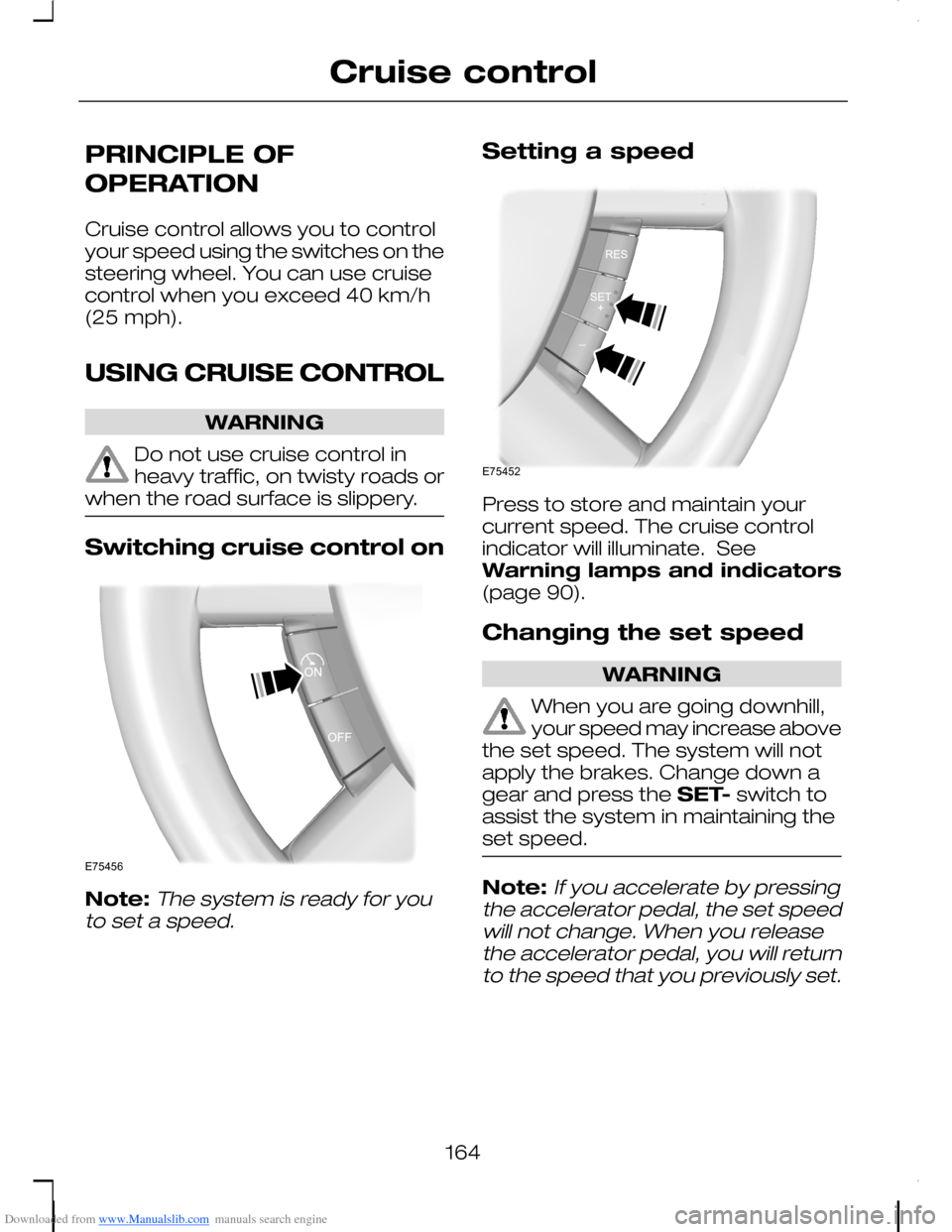
Downloaded from www.Manualslib.com manuals search engine PRINCIPLE OF
OPERATION
Cruise control allows you to controlyour speed using the switches on thesteering wheel. You can use cruisecontrol when you exceed 40 km/h(25 mph).
USING CRUISE CONTROL
WARNING
Do not use cruise control inheavy traffic, on twisty roads orwhen the road surface is slippery.
Switching cruise control on
Note:The system is ready for youto set a speed.
Setting a speed
Press to store and maintain yourcurrent speed. The cruise controlindicator will illuminate. SeeWarning lamps and indicators(page 90).
Changing the set speed
WARNING
When you are going downhill,your speed may increase abovethe set speed. The system will notapply the brakes. Change down agear and press the SET- switch toassist the system in maintaining theset speed.
Note:If you accelerate by pressingthe accelerator pedal, the set speedwill not change. When you releasethe accelerator pedal, you will returnto the speed that you previously set.
164
Cruise controlE75456 E75452